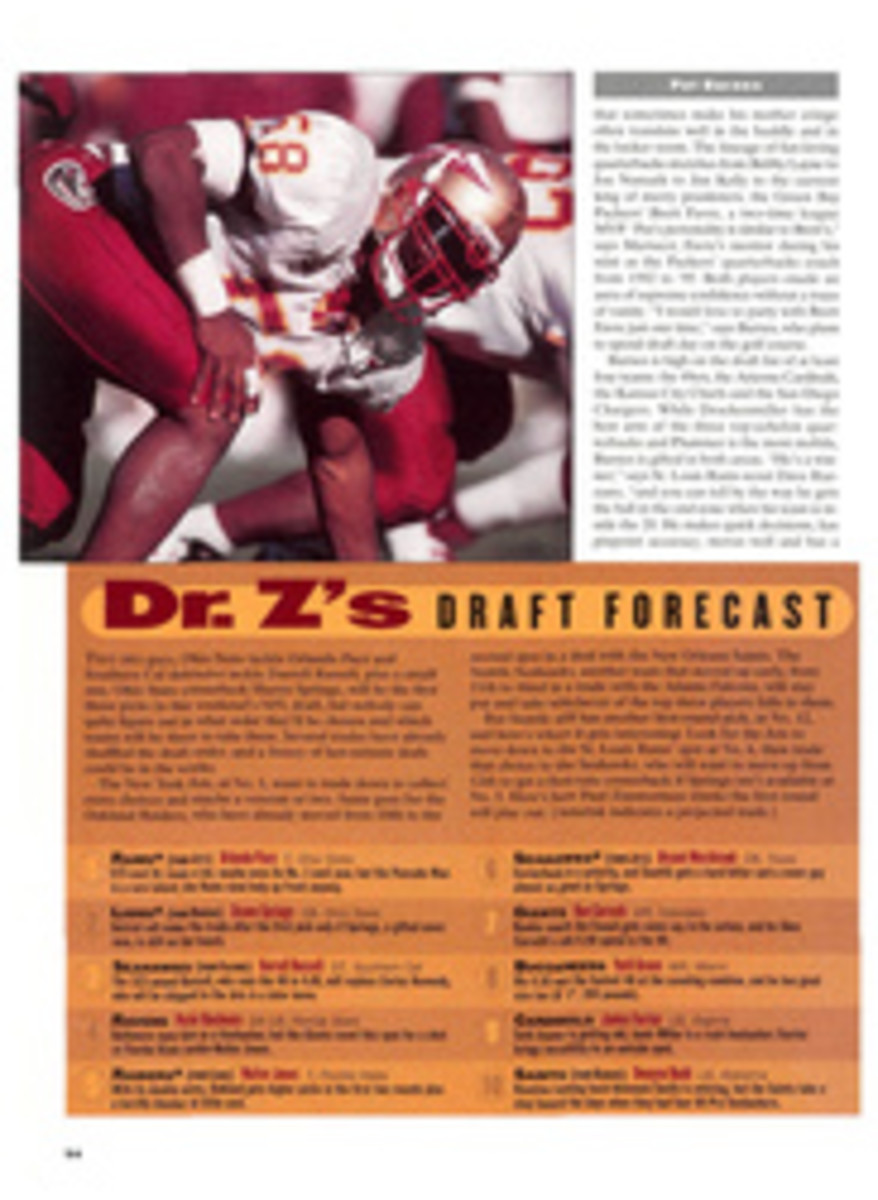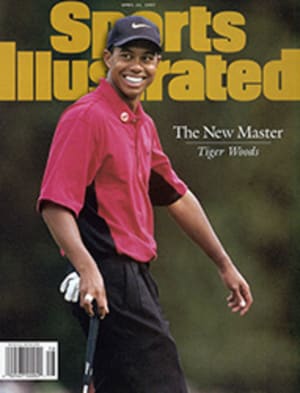
OSCAR TIME IT WASN'T AN AWARD-WINNING PERFORMANCE, BUT OSCAR DE LA HOYA TOOK PERNELL WHITAKER'S WELTERWEIGHT TITLE
Oscar De La Hoya's magnificent tour bus idled smoothly outside
the Thomas & Mack Center in Las Vegas last Saturday night,
waiting to take its young star even farther down the road to
greatness. A fourth championship belt was safely aboard, and if
a million people really did buy the pay-per-view bout, as
predicted, there would soon be new sponsors' logos joining the
ones painted alongside his likeness on the side of the bus. De
La Hoya's many shrieking fans gathered outside had to imagine
that the ride was going to be long and wonderful for them all.
Yet a few people watched the pale blue bus smoking in the
parking lot and saw a getaway car instead. To these
critics--most of them boxing writers and television
commentators--De La Hoya had just performed something more along
the lines of grand theft than assault and battery. He hadn't won
a 12-round decision from WBC welterweight champion Pernell
Whitaker, he had stolen it. The critics grumbled that it
wouldn't be a big surprise to see the ringside judges, who
scored the bout a runaway, slinking on board the bus as part of
the gang. Such is the suspicion and resentment that the
24-year-old De La Hoya seems to generate as he tears through
boxing.
The truth, though, lay somewhere between what his fans felt and
his critics reported. De La Hoya, on the basis of his
troublesome and controversial victory over the 33-year-old
Whitaker, is probably going to suffer a few more bumps than
anyone had thought on the road to whatever his final destiny
might be. He didn't manhandle Whitaker; he barely touched him.
It was mostly cat-and-mouse, and the mouse kept getting away.
Not once did De La Hoya stop Whitaker in his tracks or put two
solid punches together. The blows, what small percentage landed
(34% for De La Hoya, 40% for Whitaker), were almost all
glancing. This lack of dominance in so heavy a favorite (De La
Hoya went off at 7 to 2 despite the fact that he was moving up
to the welterweight division for the first time) does not bode
well for someone who intends to win six titles before he takes
up architecture and golf full time.
Then again, it required the heightened paranoia of boxing
writers and commentators to suggest that the victory was the
result of a conspiracy or, for that matter, anything but the
natural forces that replace old with young, traditional with
modern. The fight was close, without conclusive volleys, and
probably featured a little more of Whitaker's exaggerated sense
of artfulness than anybody needed (and a lot less of De La
Hoya's firepower than everybody else wanted). The bout was
certainly not a 9-3 or a 9-2-1 affair, which is how two of the
Nevada judges scored it (the third had it 8-4, also for De La
Hoya), but neither was it robbery. It was just a tough fight
that De La Hoya won, barely.
That he did win may have had something to do with De La Hoya's
amateur training. Emanuel Steward, the veteran trainer, thought
that De La Hoya must have figured early on that he wasn't going
to overpower so resourceful a technician as Whitaker, so he
"relied on his amateur tricks," said Steward, to be just active
enough to win rounds. For instance, if the judges were tempted
to mark De La Hoya down for his ineffective jab, he had the good
sense to close rounds with flurries, which tended to obscure
Whitaker's consistent ability to frustrate him.
If the decision was unpopular--and De La Hoya himself was
mindful enough of the dissatisfaction not to claim Whitaker's
unofficial title as the best pound-for-pound boxer in the
world--that may have had less to do with the actual fight than
with the new champion himself. Not everyone cottons to the idea
of a corporate boxer, the kind of kid whose career is shaped
more by the requirements of the endorsement world than boxing's.
His talent is impossible to ignore, and the quibbles over the
Whitaker fight notwithstanding, his future is ordained. Yet
there is resistance to a fighter whose popularity seems based on
good looks and good marketing. The fight game has not advanced
sufficiently into the 20th century that somebody with a toothy
smile and a Web site can be embraced fully.
Even Whitaker, his best days and his six championships behind
him, seemed resigned beforehand to the force of De La Hoya's
personality. Chiding De La Hoya for living like a "rock star" on
Willie Nelson's hand-me-down bus, Whitaker nonetheless wearily
conceded his opponent's appeal. At Friday's weigh-in, when
hordes of female fans, most of them Hispanic, screamed and
impersonated the bobby-soxers of generations ago, Whitaker
waited behind a curtain and said, "It must be Liberace."
De La Hoya has been better handled than any fighter before him,
with the possible exception of Sugar Ray Leonard. With his East
L.A. roots, he is marketed as an American champion in the
Midwest and as a Latino one in the barrios. But his pretty-boy
persona can be aggravating to those who like their fighters
sweaty and bloody. They see De La Hoya's rise as a case of
persona overriding achievement, or else Whitaker, who won an
Olympic gold medal eight years before De La Hoya did in 1992,
might be the one wearing a milk mustache in the four-color
magazine ads.
But this is a new era, and De La Hoya is the future of boxing,
like it or not. The fact that promoter Bob Arum has maneuvered
him through three divisions, allowing De La Hoya to make his
mark against names that had all seen better days, or that some
of De La Hoya's business affairs are overseen by the same agent
that handles Kerri Strug, does not mean the fighter has been
manufactured. Before adding Whitaker's belt to his collection,
he had held various lightweight, junior lightweight and super
lightweight titles. He has fought often enough, 24 times as a
pro without a defeat, that his ring craft and instincts are
proven. Anybody who can smile on cue and who can shrewdly cater
to both the Mexican-American constituency (a mariachi band
played before the Whitaker bout as De La Hoya continued to
appeal to fans who once belonged to the declining Julio Cesar
Chavez) and to Madison Avenue is certain to be cast as a
smoothy, at best. Yet he does deliver the goods.
Saturday night he didn't deliver enough of them to quell every
little criticism. Whitaker, who has a perverse vanity for
someone in a blood sport, was as confounding as he ever was in
his prime, though he didn't pull down De La Hoya's trunks, as he
did to one opponent years ago. There was probably nothing De La
Hoya could have done to look better against such a master of
defense; there has seldom been anything anyone could do to
Whitaker, except shortchange him on the scorecards (as was done
in bouts with Jose Luis Ramirez in 1988 and Chavez in '93).
Bobbing, weaving, dipping and circling, he can be untouchable.
Several times De La Hoya turned southpaw--for he is
"amphibious," as Whitaker's co-manager, Lou Duva, had
warned--and rocked Whitaker with righthand jabs to the head. But
most of the real contact was inside. De La Hoya, who would
rather fight outside, was drawn in by Whitaker, who used the
clinches to his advantage, often draping his right arm around De
La Hoya's shoulders and peppering him with lefts. This
infighting produced a head butt in the third round, for which
Whitaker was penalized, and a seventh-round spill when both men
went to the canvas in each other's arms. And when the distance
between the fighters increased, so too did Whitaker's ability to
parade his repertoire.
As he had promised, the defending champion was back to his old
tricks after several unremarkable recent fights. In the second
round the 5'6" Whitaker dropped his arms, dared De La Hoya to
hit him and became a virtual shape-shifter as he eluded the
taller (by five inches) and stronger man's punches. The
performance was, as he had promised, his "Siegfried and Roy" act.
The bout was fun to watch, a tremendous show, but Whitaker's
theatrics apparently did not have enough to do with boxing to
satisfy the judges. Siegfried and Roy, after all, have a white
tiger in their corner to create the illusion of danger; Whitaker
failed to produce any such thrill. He did score a knockdown in
the ninth round, but that was more a case of the two boxers'
tangled feet than Whitaker's fists. In the end Whitaker's pride
in his ability to make an opponent miss might have cost him his
chance to win the fight. Sadly, the former champion's spins and
dips may have been more fairly scored in the ballroom than in
the ring. De La Hoya's aggression, however thwarted, was better
rewarded.
Whitaker's outrage afterward was substantial, and he had to be
taken seriously, having previously been jobbed in two of his
most important fights--the loss to Ramirez and the draw with
Chavez. "This was like a nightmare all over again," he said.
"This doesn't make sense, because I destroyed the kid. I could
have knocked him out, but I was having so much fun."
Dimly aware that his style had sabotaged him, Whitaker, now
40-2-1, said, "The main thing is, that was the Pernell Whitaker
of old, whether you like it or not." That he seemed able to
recapture his youth, to circle a ring unscathed, mocking an
opponent's frustration, did not win him the points he needed in
the end. Arum was unnecessarily cruel, though, when he indicated
his disdain for a rematch by saying, "Nobody wants to see him
again."
De La Hoya, who earned $10 million for his work Saturday night
(Whitaker made $6 million), admitted his victory was incomplete,
to the extent that he failed to dispose of Whitaker in
spectacular fashion. But, he said, it was mostly because of his
opponent's southpaw stance. "That," De La Hoya said, "will make
anybody look bad, any day. I said it all along--his style is the
most difficult in boxing. He does things in the ring nobody else
does." De La Hoya also marveled at the little things Whitaker
did, like using his gloves to rake De La Hoya's eyes. "Oh, this
guy was smart, very smart," he said. "But that experience, that
goes with boxing."
Whitaker wasn't terribly impressed by Oscar the Boxer. "Well,"
he said afterward, "he did pretty good. He didn't lay down."
Whitaker did gain a certain perspective on De La Hoya, the
boxing entrepreneur, and he seemed more envious than dismissive.
"The women," Whitaker said, referring to a fan support he had
never come close to having, "he ought to thank them for the rest
of his life." Then thinking of the advantages the Kid enjoys in
this modern world, he said, "He can thank them on his dot com."
As Whitaker said this, De La Hoya's bus was rumbling away, the
pale blue beast leaving everybody else behind. There was no
catching him now.
COLOR PHOTO: MANNY MILLAN The "amphibious" De La Hoya turned southpaw at times and was able to nail the elusive Whitaker with right jabs. [Pernell Whitaker and Oscar De La Hoya boxing]
COLOR PHOTO: V.J. LOVERO Whitaker consistently made De La Hoya miss but landed few solid blows of his own. [Oscar De La Hoya and Pernell Whitaker boxing]

